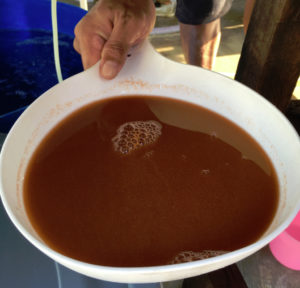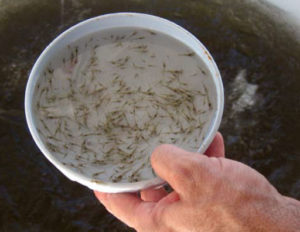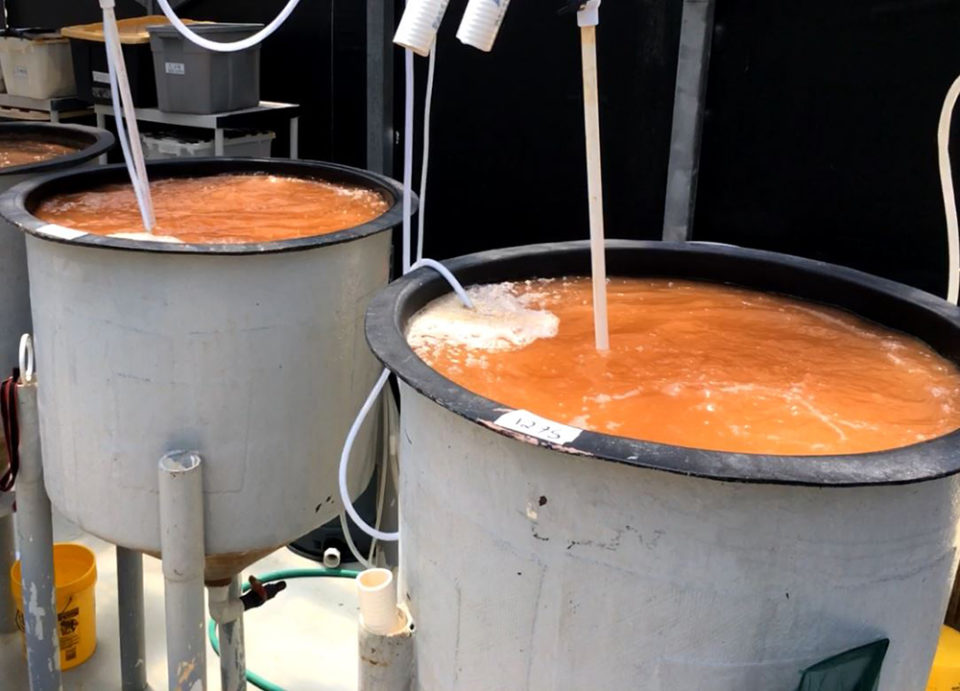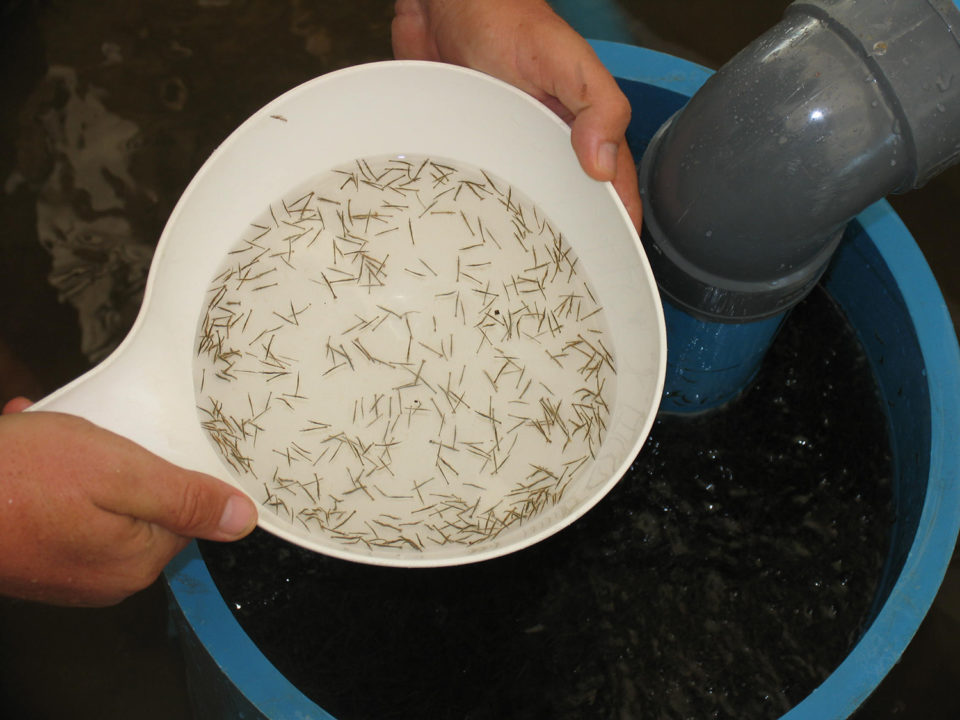Considerations for development of alternative sources of larval fish and shrimp feeds

The brine shrimp artemia is a key feed for larval stages of various commercially farmed shrimp and fish species all over the world. However, the increasing global demand for brine shrimp cysts could be a bottleneck for the continued growth of the aquaculture industry, because its supply comes from harvesting wild populations, which can sometimes be unpredictable and vary considerably depending on environmental conditions.
As an example, the brine shrimp harvests and cyst supplies from the Great Salt Lake or GSL (Utah, USA) – which provides between one-third and one-half of global supplies – can be significantly affected by various natural phenomena like variations in the salinity and water level in the lake.
Today, the supply situation for brine shrimp cysts is similar to that of fishmeal and fish oil, which reached maximum sustainable levels several years ago, when the growth of the aquaculture industry was often correlated with the growing use of these products derived from reduction fisheries. The aquafeed industry adapted and shifted from using mostly marine ingredients from capture fisheries to farmed land-based sources and industrial byproducts, all produced under controlled, scalable, sustainable and certifiable conditions.
We believe the same is possible for artemia, and here we discuss the replacement of brine shrimp cysts with a synthetic product. This article is modified from the original publication in Aqua Culture Asia Pacific 13(2), March/April 2017.
Global aquaculture growth, increasing demand for the brine shrimp artemia
Various authors have projected an additional global seafood demand in the next two decades at up to double our current annual production of around 80 million tons. For example, the recent World Bank report by Kobayashi et al. (Fish to 2030: The Role and Opportunity for Aquaculture. Aquaculture Economics & Management Vol. 19, Issue 3, 2015) predicted that global seafood supply will increase from 154 million tons in 2011 to 186 million tons in 2030, with essentially all of the increase coming from aquaculture expansion. The report also projected the fastest growth for tilapia and shrimp (over 90 percent increase), and the largest industry expansion expected in India, Latin America, the Caribbean and Southeast Asia, all major shrimp farming areas. Brine shrimp, or rather, the nutrition it provides to larval shrimp, is critical in the production of shrimp postlarvae (PLs).

Doubling global seafood production poses some major technical challenges, including sufficient supply of feeds and feed ingredients, and the supply of brine shrimp supply is one of these challenges. The three main regions producing brine shrimp in the world are the GSL, Russia and China. According to Litvinenko et al. (Artemia cyst production in Russia. Chin. J. Oceanol. Limnol., 33(6): 1436-1450. 2015), total global production of artemia in recent years has been between 3,000 and 4,000 tons per year. Out of this total, the GSL produces 1,000 to 2,000 tons, Russia 550 tons, Kazakhstan 20 tons; Uzbekistan 20 tons; China (Bohai Bay, Mongolia, Aibi, Balikun and other areas), 900 tons; Vietnam, 20 tons; and other countries (Thailand, Argentina, Brazil and others) another 60 tons or so.
However, the continued harvesting of a natural resource like brine shrimp cysts may not be a viable, long-term alternative to support the projected growth of aquaculture. There is evidence that harvesting of these populations may have negative effects. For example, the recent research by Sura and Belovsky (Impacts of harvesting on brine shrimp (Artemia franciscana) in GSL. Ecol Appl. 2016 Mar; 26(2): 407-14. 2016) on cysts harvested from the GSL from 1991 to 2011 concluded that cyst buoyancy had decreased and nauplii mortality had increased over time. The authors concluded that harvesting brine cysts in the GSL – believed to be the best managed brine shrimp resource in the world – is causing evolutionary changes that could affect future sustainable harvests and management of the resource.
Understanding artemia use in shrimp hatcheries
Most brine shrimp cysts are used to produce Pacific white shrimp (Litopenaeus vannamei) and black tiger shrimp (Penaeus monodon), with each species having different feeding characteristics. The latter, up to the PL20 stage, are mainly pelagic feeders foraging in the upper water column; they are mostly reared in flat bottom tanks and are not efficient bottom feeders, making it difficult to feed them with dry diets until they are harvested, as they can only feed on what is in the water column in a flat bottom tank (i.e. live brine shrimp). Typically, 5 to 10 kg of artemia 80 percent hatch-out cysts are used to rear each million P. monodon PLs harvested.
Pacific white shrimp are pelagic feeders up to the PL5 stage, and then become bottom feeders from PL6 until harvest – this allows significant use of inert dry diets in the later stages and reducing the amount of brine shrimp required. These shrimp are mainly reared in tanks with parabolic bottoms until PL5. After PL5, artemia hatched from cysts are no longer used as feeds and the animals are fed at the bottom with heavier, sinking diets as well as de-capsulated cysts or artemia biomass. It is typical to use 1 to 5 kg of artemia 80 percent hatch-out cysts/million L. vannamei PLs harvested.
In the Eastern Hemisphere, shrimp larvae are customarily fed hatched artemia based on visual macroscopic observations by technicians of the available feed in the water column, and microscopic observations uncommon. Larval production tanks typically are flat-bottomed and have relatively low aeration levels, and maintaining artificial feeds in suspension is harder.
For these reasons, there is a very high dependence on live brine shrimp, which can be easily maintained in suspension and are easy to observe with the naked eye. In contrast, the use of artificial diets is considerably higher in the Western Hemisphere, and feed applications are depend more on frequent microscopic observations of the animals than on the water column. Larval rearing tanks have parabolic bottoms with strong aeration in the center to maintain suspended all feeds and to minimize dependence on live feeds.

A better alternative
The use of brine shrimp cysts in hatcheries has many benefits but also has some major drawbacks. The latter include a high variability in availability, nutritional value, hatch rates and cost. Hatching and rearing of artemia requires significant infrastructure, labor and time, which are often not accounted for in the cost of using cysts. Artemia can be a potential disease vector and a biosecurity concern, particularly for Vibrio infections. And the microsporidian parasite that causes the EHP disease, Enterocytozoon hepatopenaei, has been identified in artemia biomass.
On the other hand, a completely artificial or synthetic artemia replacement provides several benefits, including a consistent nutritional profile that can equal or exceed that of artemia nauplii. Artificial diets have consistent availability and quality, can be certified as pathogen-free with no biosecurity issues, have no inconsistencies related to hatching percentages or presence of shells and unhatched cysts, and impose no infrastructure or variable costs to the hatchery. They can deliver enzymes, immunostimulants and other beneficial products, and also probiotics to improve digestion, animal health and water quality. Therefore, using an artificial, biosecure product that delivers the nutritional needs and can be produced on demand improves operations and predictability and helps reduce risks.

Perspectives
For developing shrimp larvae, liquid diets offer various advantages versus other products like dry diets. Liquid diets have a semi-moist texture, are highly palatable, attractive and water stable; and can significantly reduce leaching and water pollution in the larval production tanks. They are microencapsulated and the cold manufacturing process protects sensitive ingredients – like fatty acids, pigments, enzymes and others – from heat degradation.
Recognizing the limitations and biosecurity risks of live feeds, our company developed a commercial, cost-effective, liquid synthetic artemia after almost two decades of experience and continuous improvement. It is designed to completely replace artemia cysts by up to 100 percent, depending on various factors. It has near neutral buoyancy and is formulated to match the nutritional profile of high-quality enriched artemia with high levels of highly unsaturated fatty acids (HUFAs), with an optimal nutrient composition for shrimp postlarvae.
This artemia replacement provides consistent nutrition and constant availability/supply, can be used without any disinfection or hatching costs, and has significantly lower costs than traditional artemia cysts. And by helping maintain adequate water quality and dissolved oxygen levels, its use can extend the transport time of shrimp postlarvae from hatchery to nursery or farm.
In part 2 we will discuss results of hatchery and pond trials at commercial facilities, as well as some perspectives for this important resource.
Authors
-
Craig Browdy, Ph.D.
Director of Research & Development
Zeigler Bros., Inc.
Gardners, PA USA
-
Peter Van Wyk, M.A.
R&D Technical Manager
Zeigler Bros., Inc.
Gardners, PA USA -
Chris Stock, M.S.
Sales Manager, Eastern Hemisphere
Zeigler Bros., Inc.
Gardners, PA USA[109,111,99,46,100,101,101,102,114,101,108,103,105,101,122,64,107,99,111,116,115,46,115,105,114,104,99]
-
Diego Flores
Technical Representative, Hatchery Feeds, Western Hemisphere
Zeigler Bros., Inc.
Gardners, PA USA -
Ramir Lee
Technical Representative, Hatchery Feeds, Eastern Hemisphere
Zeigler Bros., Inc.
Gardners, PA USA
Tagged With
Related Posts

Innovation & Investment
Artemia, the ‘magic powder’ fueling a multi-billion-dollar industry
Artemia, microscopic brine shrimp used as feed in hatcheries, are the unsung heroes of aquaculture. Experts say artemia is still inspiring innovation more than 50 years after initial commercialization. These creatures are much more than Sea-Monkeys.

Health & Welfare
How good are your shrimp postlarvae?
Stocking the best quality shrimp postlarvae, healthy and free of pathogens, is a critical management step with significant effects on the production and profitability of a shrimp farm.

Aquafeeds
Biofloc consumption by Pacific white shrimp postlarvae
The stable isotopes technique with δ13C and δ15N can be used to determine the relevance of different food sources to shrimp feeding during the pre-nursery phase of Litopenaeus vannamei culture. During this trial, different types of commercial feed, microalgae, Artemia sp. nauplii and bioflocs were used as food sources.

Health & Welfare
A holistic management approach to EMS
Early Mortality Syndrome has devastated farmed shrimp in Asia and Latin America. With better understanding of the pathogen and the development and improvement of novel strategies, shrimp farmers are now able to better manage the disease.


